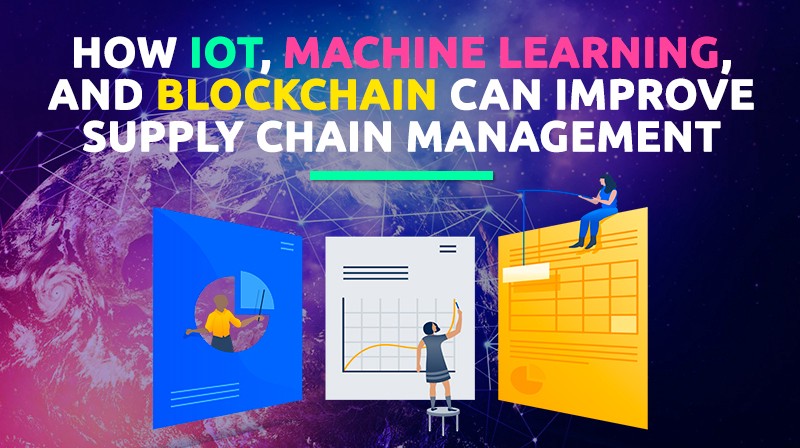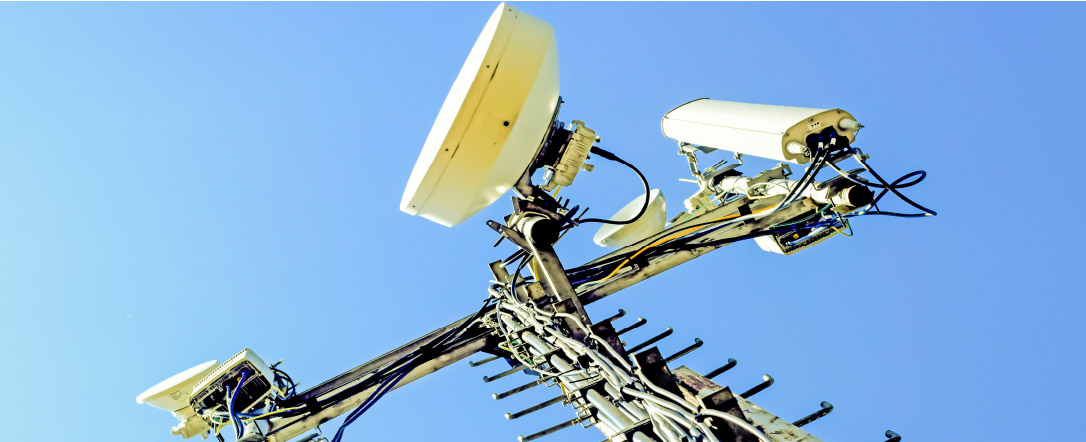How IoT, Machine Learning, and Blockchain Can improve Supply Chain Management

Traditionally, the supply chain has been characterized by siloed operations with barely any cross-functional integration; in other words, the system has been complicated, disconnected, and unintelligent. This lack of integration has resulted in the lack of end-to-end visibility and increased the cost of tracking the movement of products across the supply chain. Deloitte’s 2013 Global Supply Chain Risk Survey found out that companies were having challenges managing sudden demand changes and margin erosion, mostly because they lack the latest tools.
One of their biggest concerns related to the risks inherent in their extended supply chain (I.e. their suppliers operations) are due to visibility shortages. Of course, many companies are often struggling when it comes to mastering procurement and data flows within their tiers, having no choice but to trust their stakeholders-both internal and external. While a majority of brands are using outsourcing as a business leverage, most companies fail when trying to find a way to have reliable visibility over their entire supply chains while limiting the dependence on one or several stakeholders.
The food and car industries, for instance, have suffered huge fines, recalls, and sales losses that lead up to US$100 millions. As a result, there is the need to make supply chain information more reliable, traceable, and improve visibility. Three critical technologies are combining the technological muscle to realize explosive opportunities for the supply chain space and these include: the Internet of Things, Machine Learning and blockchain technology.
Internet of things (IoT)
According to Gartner, more than 50% of major business processes are set to incorporate some element of IoT come 2020. The study projects that 26 billion IoT devices will be installed and this will generate $300 billion by the end of the decade. Another Forrester’s study revealed that 58%-77% of organizations surveyed considered locating objects, personnel, and containers as major IoT functions for supply chain management.
According to Kaleido insights, IoT refers to the interconnectivity of the digital and physical worlds, wherein embedded sensors connect and integrate ‘things’ –objects, animals, plants, people, devices, machines, infrastructure, and environments –to information networks. Interconnectivity between these things digitizes new context (e.g., position) and can generate new value constructs (e.g., location-based services).
Impact of IoT in Supply Chain Management
IoT is sure to impact supply chain management with operational efficiencies as well as revenue opportunities.
Operational efficiencies
This includes:
Asset Tracking. Unlike barcodes and numbers, IoT uses new RFID and GPS sensors to track assets from ‘floor to store’ and from ‘farm to table.’ These sensors can provide such granular data like the temperature at which the item was stored (according to the Food and Agriculture Organization of the UN, up to 1/3 of food perishes in transit every year; stable temperature, unlike varying temperatures, ensure greater preservation.), how long a product spent in cargo and how long on the shelf. This will enhance a tighter grip on on-time delivery, quality control, product and demand forecasting.
Vendor Relations. According to IBM, 65% of a product’s value depends on the suppliers. The data from asset tracking will enable organizations to determine sub-par vendor relations that are costly versus those that are profitable. It will also help organizations adjust production schedules according to demand levels.
Forecasting and inventory. Amazon, for instance, is using WIFI robots for scanning and tracking QR codes on its products and placing triage orders. Apart from ensuring you don’t miss any deadline, forecasting from IoT data will ensure manufacturing schedules are more efficient.
Connected fleets. Just like cities are making use of these data to get to emergencies faster or clear up traffic issues (traffic delays account for late deliveries and shortages in stock), manufacturers and suppliers are using IoT to get better products to their customer more quickly. Cisco, for instance, partnered with California Shock Trauma Air Rescue air ambulance services for efficiencies in their dispatch systems. When an emergency arises, the public safety answering point that is geo-matched to the nearest air ambulance crew that would then be dispatched. The crew is able to keep communicating through one system enabled by IoT.
Scheduled maintenance. IoT smart sensors on manufacturing floors can relay data on which machines need maintenance. This ensures planned and predictive maintenance to prevent costly downtimes.
Revenue opportunities
IoT data that is analyzed gives insights, forecasts, and trends for a 360-degree view of the customer, their purchasing habits, and business processes. This understanding helps businesses form tighter relations with their customers hence better and innovative ways of marketing to the consumers. IoT could help businesses get more creative, innovative, transparent, and improve on social responsibility when it comes to supply chain management.
While the idea behind the quirky TV show Portlandia may appear fictional, it’s, in fact, very real with IoT. Actors insist on knowing details about the chicken they are about to take for dinner. They can find details about it and even travel to where it has grown; an option made possible by the restaurant.
Machine learning
According to innovation enterprise, “Machine learning is a form of artificial intelligence able to learn without human programming it to specifically find something. Machine learning algorithms do this by searching large data sets for meaningful patterns, from which future events can be predicted or classified. It finds the sort of patterns that are often imperceptible to traditional statistical techniques because of their apparently random nature.”
Organizations realize end-to-end automation through machine learning. Gartner predicts that the level of adoption for ML is set to double in the next five years. ML impacts the supply chain in the following ways:
ML algorithms are analyzing big data from IoT. ML systems can collect, analyze and even adjust data sets from a wide range of data sources efficiently and cheaply. It can match and combine data sets, for instance, an employee’ sick days off, to external factors such as unfavorable weather patterns. This would then be used to build the complete picture of potential stumbling blocks and ensure specific levels of supply are met. This is particularly critical for perishable goods handlers like grocery stores when overstocked the supply will perish, and customers may also not tolerate empty shelves. Early adopters of ML are already reaping up to 80% reductions in stock-out rates, more than ten days reduction in inventory on hand and write-offs, and are earning gross margin growths of up to 9%. Weather conditions pose one of the most significant challenges for businesses; from transportation to farming and even business establishments like buildings. For instance, heat waves and drought that hit Russia in 2010 resulted in $15 billion losses.
A UK Met office conducted a survey of supply chain professionals and found out the following: 16% of the professionals said they use commercial weather data, and their results are persuasive! 57% of the professionals had better sales forecast accuracy, 51% had better shelf availability of products, and 43% had reduced waste. IBM is set to inject cognitive technology to ‘deep thunder’ a hyper-local weather forecasting tool for businesses to enhance its services. When combined with ML, it can produce excellent accuracy on impacts of weather on specific locations. ML does not only identify patterns that show particular risk; it recommends mitigating actions based on its examination of previous responses to similar risks particularly those that were more successful.
Reduces operational risks for employees by taking of menial jobs. We are already witnessing driverless cars that will turn to driverless trucks that will automate the transportation of goods. This reduces dependence on overly tired drivers who cause accidents risking their own lives and that of others, and will eliminate the chances of taking wrong routes. It will also reduce the need for warehouse workers; ARC’s survey found out that 15% of warehouse executives are set to procure autonomous mobile robots for their warehouses.
Blockchain Technology
According to big data zone, “Blockchain is a distributed database system that acts as an ‘open ledger’ to store and manage the transaction.” Blockchain brings three key components to the supply chain: reliability, integrity, and speed which are fundamental for any supply chain. The blockchain technology accomplishes this through the following features:
· Consensus. All the entities in the blockchain must agree to each transaction being valid; whether payment, delivery, warehousing or transportation.
· Provenance. Every entity in the blockchain knows where every asset came from; who was the previous owner and at what time.
· Immutability. No one can tamper with any entry; simply put, no fraud, no impersonation, no falsification of records like inventory, delivery times, and warehouse conditions among others.
· Decentralized copies of the ledger will all hold the same truth.
· Blockchain will allow supply chain partners to create trusted relationships without needing any intermediaries like banks.
· Blockchain enables for direct communication between the supplier and consumer hence cutting down on costs.
· Much more important, smart contracts in the blockchain will enable for more agility in the supply chain. Businesses will automatically connect, negotiate and close business deals with partners across the supply chain from all over the globe and have the whole process taken care of up to payment and beyond. This will help participants speed up production and innovation that meets the changing needs of customers and help realize more trusted and fruitful relationships. Smart contracts are self-executing sets of agreed-upon rules for a particular transaction. Smart contracts will also help monitor the flow of goods according to demand so that if there is a demand, then smart contracts execute for the flow of goods and when there is a surplus then smart contracts trigger storage of excess goods or limits supply. And the good part is that there are various platforms out there such as DAPP BUILDER which seeks to help businesses/users to easily create and edit smart contracts without the need for any coding skills.
There are several companies working in the supply chain management sector that are engaging blockchain to increase accountability and record-keeping quality. For instance, a private-public initiative spearheaded by the Coca-Cola Co. (KO) and the United States Department of State will use blockchain technology to combat forced labor in their supply chains. The joint effort will seek to directly address these problems by employing blockchain and smart contracts to deliver greater transparency and record-keeping regarding workers and their contracts.
The Bottom Line
These three technologies when properly leveraged can interact to form a formidable force. For instance, Walmart is using IoT sensors in conjunction with blockchain to enhance food security by increasing the traceability of products from the point of origin to the time it is sold to the consumer. This offers Walmart’s customers credible insights on the origin of their food. With Walmart producing 40 petabytes of data every day, blockchain ensures the data is immutable, reliable/verifiable and traceable. But ML crowns it all by delivering all the lavish benefits as enlisted in the above discourse. This is incredible! Supply chain professionals can deliver to the sky and beyond with these three technologies.
Source: https://medium.com/@networkteam

Commentaires récents